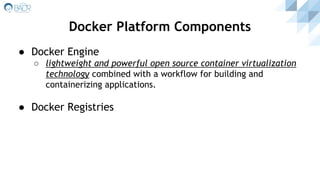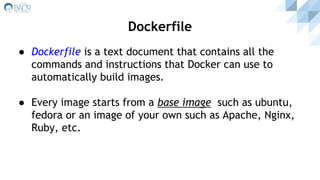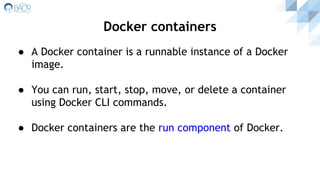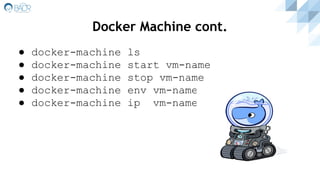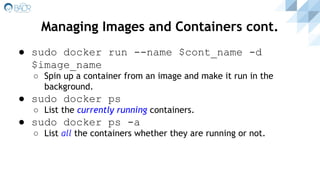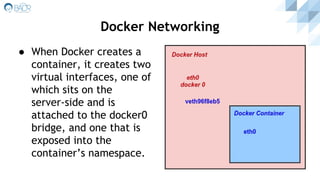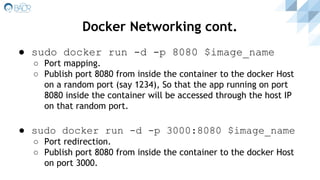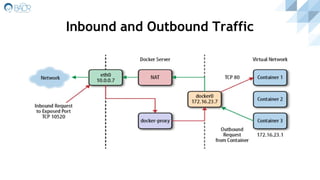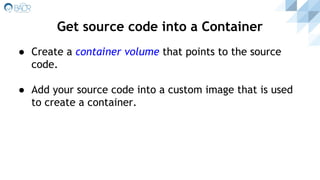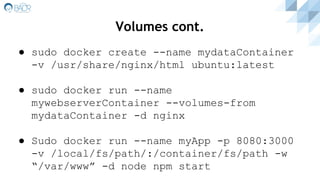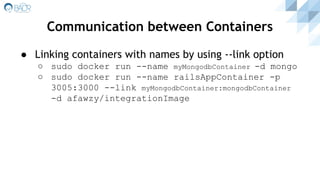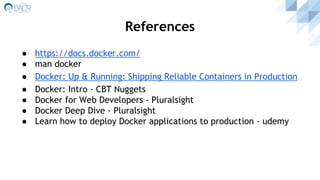Docker Up and Running for Web Developers
- 2. Docker Up and Running for Web Developers Amr Fawzy Mohammed
- 3. Outline ● What is Docker ? ● Docker Overview ● Why Docker ? ● What is the Docker platform ? ● Union file systems ● What happens when you run a container ? ● Install Docker ● Managing Images and Containers ● Docker Networking ● Get source code into a Container ● Volumes ● Communication between Containers
- 4. ● First we need to know what Containers actually are or what they bring to the table, in order to do this we need to briefly review the history of an application's runtime environment. What is Docker ?
- 5. ● In the beginning we used to build applications directly on physical servers in 1:1 ratio. Application's Runtime Environment
- 6. ● Disadvantages of this technique: ○ Every application requires a ton of infrastructure. ○ It takes a lot of time to deploy or scale an app. ○ Financially, that was a highly expensive. ○ It causes massive waste of resources. ■ Most of the time these servers run at a tiny fraction of their capabilities. Application's Runtime Environment cont.
- 7. ● This solution was not meant to be last for a long time. ● Virtualization takes place. Application's Runtime Environment cont.
- 8. ● Virtualization technology enables to build multiple virtual machines on top of a physical machine which means running multiple applications on top of a single physical server. Application's Runtime Environment cont.
- 9. Application's Runtime Environment cont.
- 10. ● Each virtual machine has it's own OS which is considered a huge overhead and a massive waste of the host physical machine's resources. Application's Runtime Environment cont.
- 11. ● The efficient solution was using Containers. Application's Runtime Environment cont.
- 12. ● Containers are way more lightweight than Virtual machines (no Guest OS). ● Each Container consumes less CPU,RAM,Disk space than a VM, But still provides a secure isolated runtime environment for the application. Application's Runtime Environment cont.
- 13. Application's Runtime Environment cont.
- 14. ● Technologies that allow you to package and isolate applications from the rest of the system. ● Containers make it easy to Deploy Applications without massive headaches, rewriting, and break-fixing. What are containers ?
- 15. ● Chroot system call ○ Seeds for today’s containers were planted in 1979 with the addition of the chroot system call to Version 7 Unix. ● FreeBSD jail ○ In 2000, FreeBSD 4.0 was released with a new command called jail which expanded chroot’s capabilities. A brief history of containers
- 16. ● Solaris Zones ○ In 2004, Sun released an early build of Solaris 10, which included Solaris Containers, and later evolved into Solaris Zones. ● HP-UX Containers ○ In 2007, HP released Secure Resource Partitions for HP-UX later renamed to HP-UX Containers. A brief history of containers cont.
- 17. ● Linux Containers (LXC) ○ In 2008, Linux Containers (LXC) were released in version 2.6.24 of the Linux kernel. ● Docker ○ In 2013, the phenomenal growth of Linux Containers starts to grow with the inclusion of user namespaces in version 3.8 of the Linux Kernel and the release of Docker one month later. A brief history of containers cont.
- 18. ● Docker is a platform for Developers and System Admins to develop, ship, and run applications. ● Docker provides the ability to package and run an application in a loosely isolated secured environment called a container. Docker Overview
- 19. ● Faster delivery of your applications. ● Faster deployment makes for easier management. ○ Docker speeds up the work flow, so it gets easier to make lots of small changes instead of huge updates. ○ Smaller changes mean reduced risk and more uptime. Why Docker ?
- 20. ● Docker helps developers to care about their applications inside containers while sysadmins work on running the container in your deployment. ● “This separation of duties streamlines and simplifies the management and deployment of code” Why Docker ? Cont.
- 21. ● Deploy and scale more easily. ● Docker containers run (almost) everywhere. ● Ensure consistency between environments. Why Docker ? Cont.
- 22. ● We can run more containers on a given hardware combination than if you were using virtual machines. Why Docker ? Cont.
- 23. ● Eliminate applications conflicts. ● Less OS maintenance (only the host OS). ● Ultimate portability between multiple environment. ● Setup development environment very quickly. ● Ship software faster. ● Fast deployment. ● Allows very easy scalability. ● Opens massive opportunities for automated testing. ● Moves control of the environment to the development team. Summarizing Docker Benefits
- 24. ● Docker provides a platform to manage the lifecycle of your containers: ○ Encapsulate your applications into Docker containers. ○ Distribute and ship those containers to your teams for further development and testing. ○ Deploy those applications to your production environment. What is the Docker platform ?
- 25. ● Docker Engine ○ lightweight and powerful open source container virtualization technology combined with a workflow for building and containerizing applications. ● Docker Registries Docker Platform Components
- 27. ● A client-server application with these major components: ○ Server (docker daemon) ○ A REST API ○ Client (CLI) Docker Engine
- 28. ● The Docker daemon runs on a host machine. ● The user uses the Docker client to interact with the daemon. ● The daemon creates and manages Docker objects, such as images, containers, networks, and data volumes. Docker Daemon
- 29. ● In the form of the docker binary. ● It accepts commands from the user and communicates with the Docker daemon. ● One client can communicate with multiple unrelated daemons. Docker Client
- 30. ● Union file systems allow files and directories of separate file systems, known as branches, to be transparently overlaid, forming a single coherent file system. ● Docker uses union file systems to combine these layers into a single image. Union file systems
- 31. Union file systems cont. ● These layers are one of the reasons Docker is so lightweight. ○ When you change a Docker image, a new layer is built and replaces only the layer it updates. ○ To distribute the update, you only need to transfer the updated layer. ● Layering speeds up distribution of Docker images.
- 32. ● A docker image is a read-only template. ● Docker images are the basis of the Docker containers. ● Docker images are the build component of Docker. ● You can build images from scratch or download and use images created by others. Docker images
- 33. ● Dockerfile is a text document that contains all the commands and instructions that Docker can use to automatically build images. ● Every image starts from a base image such as ubuntu, fedora or an image of your own such as Apache, Nginx, Ruby, etc. Dockerfile
- 34. Dockerfile cont. ● Each instruction in the Dockerfile creates a new layer in the image. ● Each image consists of a series of layers. ● Creating Image from Dockerfile ○ sudo docker build -t $image_name .
- 35. ● FROM : Specify the base image ● MAINTAINER : Specify the image maintainer ● RUN : Run a command ● ADD : Add a file or directory ● EXPOSE : expose ports to be accessed ● ENV : Create an environment variable ● CMD : What process to run when launching a container from this image. Some Dockerfile instructions
- 36. ● A Docker container is a runnable instance of a Docker image. ● You can run, start, stop, move, or delete a container using Docker CLI commands. ● Docker containers are the run component of Docker. Docker containers
- 37. Images, Containers and layers
- 38. ● A docker registry is a library of images. ● A registry can be public or private. ● Can be on the same server as the Docker daemon or Docker client, or on a totally separate server. ● Docker registries are the distribution component of Docker. Docker registries
- 39. ● $ docker run -i -t ubuntu /bin/bash ● This command tells the Docker daemon to create and start a container using the ubuntu image, run it in an interactive mode (-i),Allocate a pseudo-TTY and to run the /bin/bash command. ● So, what actually the Engine does behind the scene ?! What happens when you run a container ?
- 40. ● Pulls the ubuntu image. ● Creates a new container. ● Allocates a filesystem and mounts a read-write layer. ● Allocates a network / bridge interface. ● Sets up an IP address. ● Executes the /bin/bash executable. ● Captures and provides application output. ○ (due to interactive mode) What happens when you run a container? Cont.
- 41. ● Docker Engine is supported on Linux, Cloud, Windows, and macOS. ● For Linux use the script on this link : − https://get.docker.com/ ● For Windows or Mac Docker can be installed using Docker Toolbox Install Docker
- 42. ● Consists of : ○ Docker Client ○ Docker Machine ○ Docker kitematic ○ Docker Compose Docker toolbox
- 43. ● Docker machine is a tool that can be used to ○ Create Docker hosts on your Mac or Windows box, on your company network, in your data center, or on cloud providers. ○ Manage this host (start,stop,restart,..etc). ○ Upgrade the Docker client and daemon. ○ Configure a Docker client to talk to your host. Docker Machine
- 44. ● docker-machine ls ● docker-machine start vm-name ● docker-machine stop vm-name ● docker-machine env vm-name ● docker-machine ip vm-name Docker Machine cont.
- 45. ● sudo docker search $image_name ○ Search for an image on Docker hub repository. ● sudo docker pull $image_name ○ Pull the required image from docker hub repository. ○ Update the installed images if there is any new updates. ● sudo docker images ○ List all images on the system. ● sudo docker rmi $image_name ○ Remove an image. Managing Images and Containers
- 46. ● sudo docker run --name $cont_name -d $image_name ○ Spin up a container from an image and make it run in the background. ● sudo docker ps ○ List the currently running containers. ● sudo docker ps -a ○ List all the containers whether they are running or not. Managing Images and Containers cont.
- 47. ● sudo docker rm $container_name ○ Remove a stopped container. ● sudo docker rm -f $container_name ○ Force remove a container. ● sudo docker stop $container_name ○ Stop a running container. ● sudo docker inspect $container_name OR $image_name ○ This displays all the information available in Docker for a given container or image. Managing Images and Containers cont.
- 48. ● sudo docker exec -it $container_name <command> ○ Attach to the the running container. ○ Modify this running container. ● sudo docker commit $container_name $image_name ○ Commit the modified container into image. Creating Image from a modified container
- 49. ● When Docker creates a container, it creates two virtual interfaces, one of which sits on the server-side and is attached to the docker0 bridge, and one that is exposed into the container’s namespace. Docker Networking
- 50. ● sudo docker run -d -p 8080 $image_name ○ Port mapping. ○ Publish port 8080 from inside the container to the docker Host on a random port (say 1234), So that the app running on port 8080 inside the container will be accessed through the host IP on that random port. ● sudo docker run -d -p 3000:8080 $image_name ○ Port redirection. ○ Publish port 8080 from inside the container to the docker Host on port 3000. Docker Networking cont.
- 51. Docker Networking cont. ● sudo docker run -d --net=host $image_name ○ Host Networking. ○ Share the host IP address. ● sudo docker inspect $container_name | grep IPAddress ○ Get the IP Address of the running container.
- 52. Inbound and Outbound Traffic
- 53. ● Create a container volume that points to the source code. ● Add your source code into a custom image that is used to create a container. Get source code into a Container
- 54. ● A special type of directories in a container typically referred to as a “data volume”. ● Can be shared and reused among containers. Volumes
- 55. Volumes cont. ● sudo docker create --name mydataContainer -v /usr/share/nginx/html ubuntu:latest ● sudo docker run --name mywebserverContainer --volumes-from mydataContainer -d nginx ● Sudo docker run --name myApp -p 8080:3000 -v /local/fs/path/:/container/fs/path -w “/var/www” -d node npm start
- 56. Communication between Containers ● Linking containers with names by using --link option ○ sudo docker run --name myMongodbContainer -d mongo ○ sudo docker run --name railsAppContainer -p 3005:3000 --link myMongodbContainer:mongodbContainer -d afawzy/integrationImage
- 57. Communication between Containers ● Create a custom bridge network and add containers into it. ○ sudo docker network create --driver bridge isolated_network ○ sudo docker run --name mongodbContainer --net=isolated_network -d mongo ○ sudo docker run --name railsAppContainer -p3005:3000 --net=isolated_network -d afawzy/integrationImage
- 58. References ● https://docs.docker.com/ ● man docker ● Docker: Up & Running: Shipping Reliable Containers in Production ● Docker: Intro - CBT Nuggets ● Docker for Web Developers - Pluralsight ● Docker Deep Dive - Pluralsight ● Learn how to deploy Docker applications to production - udemy

























